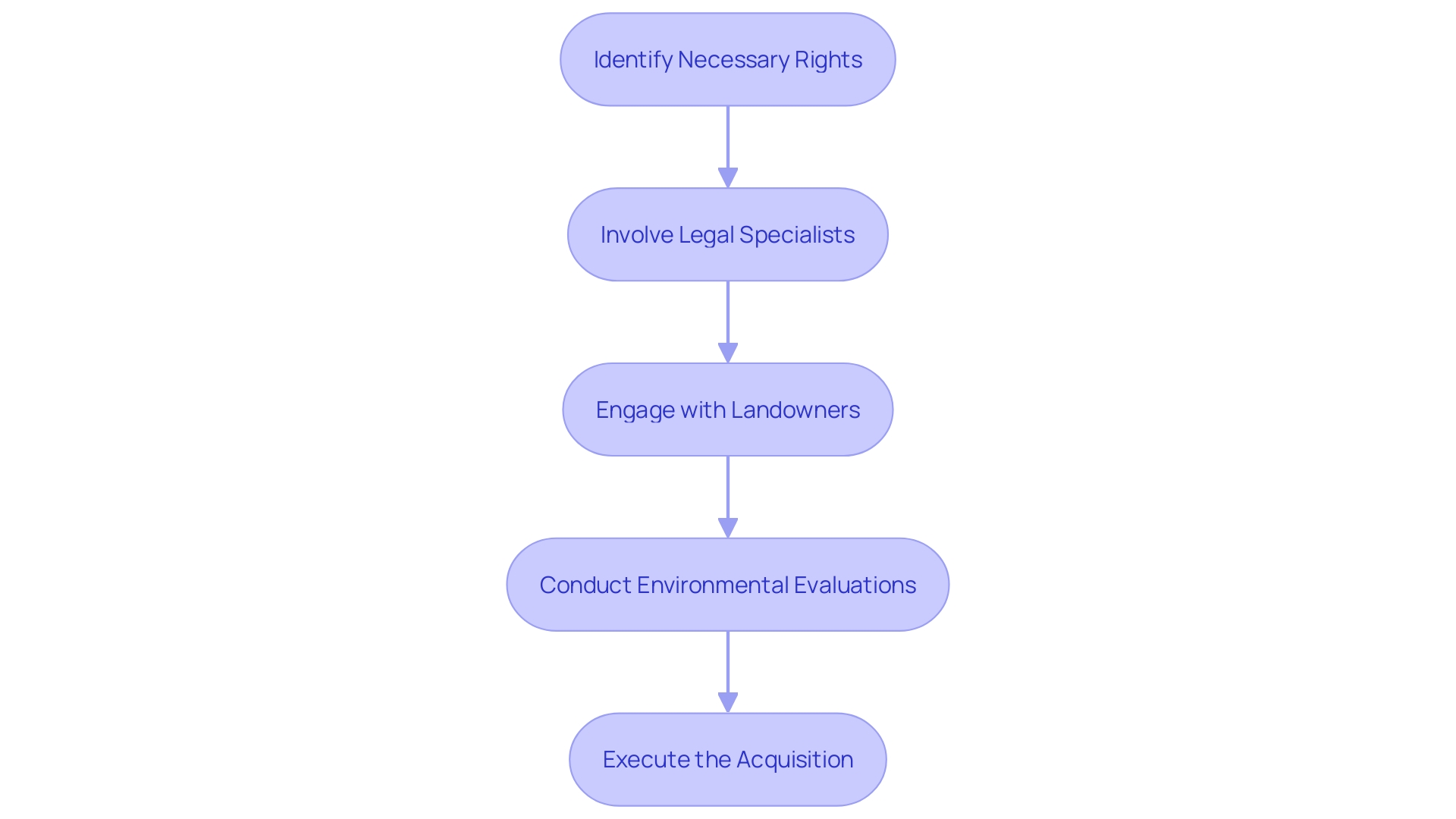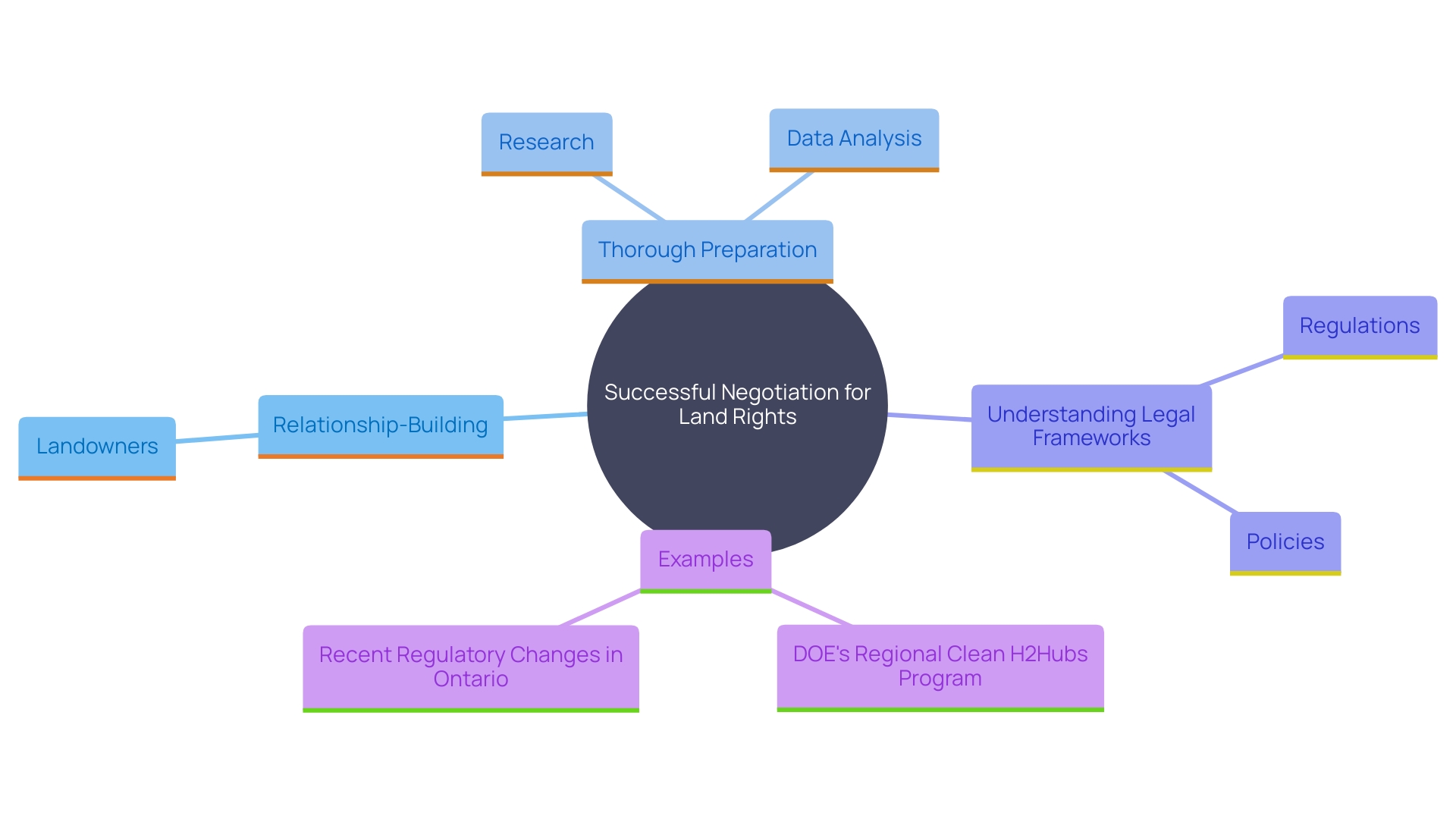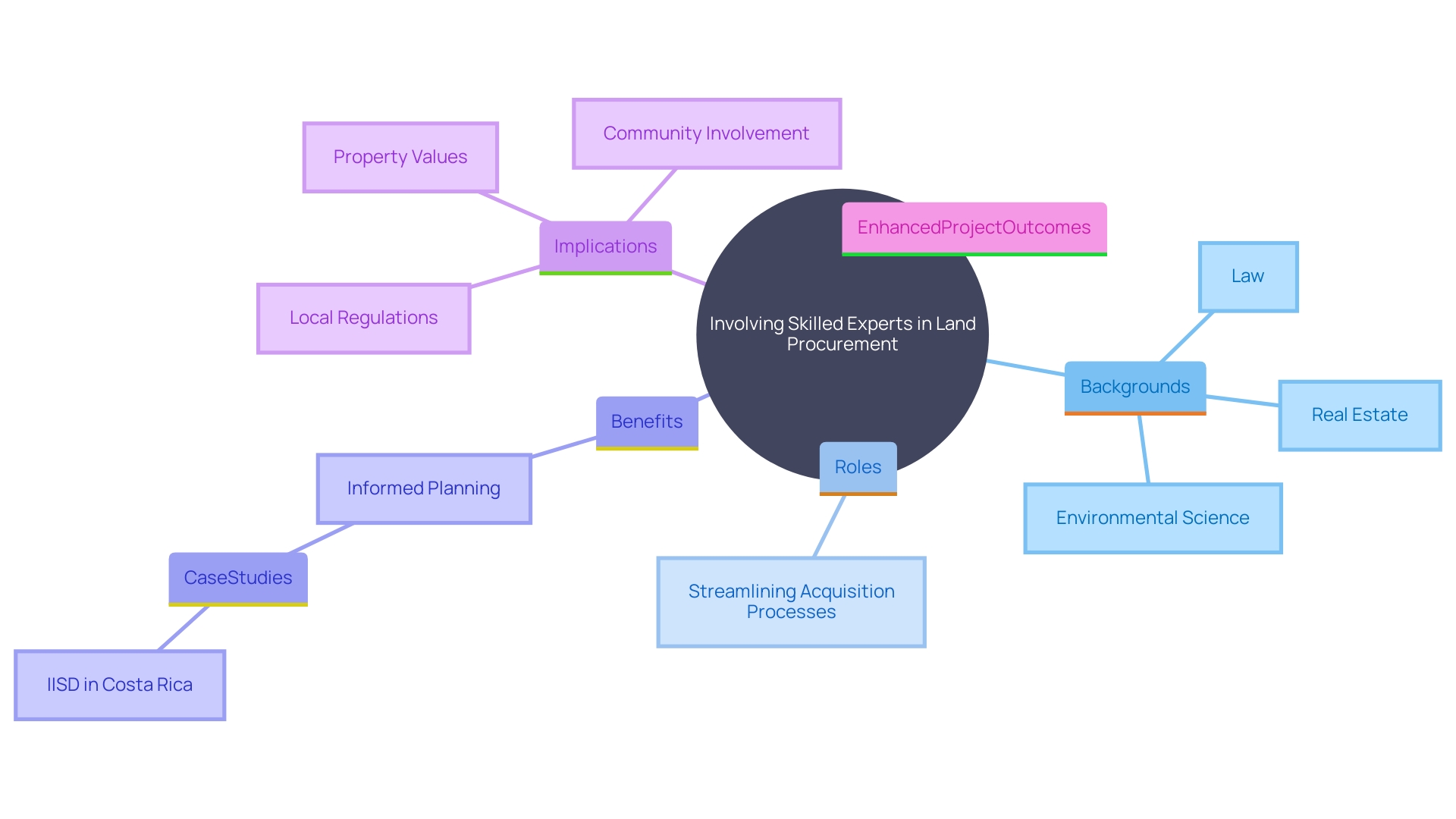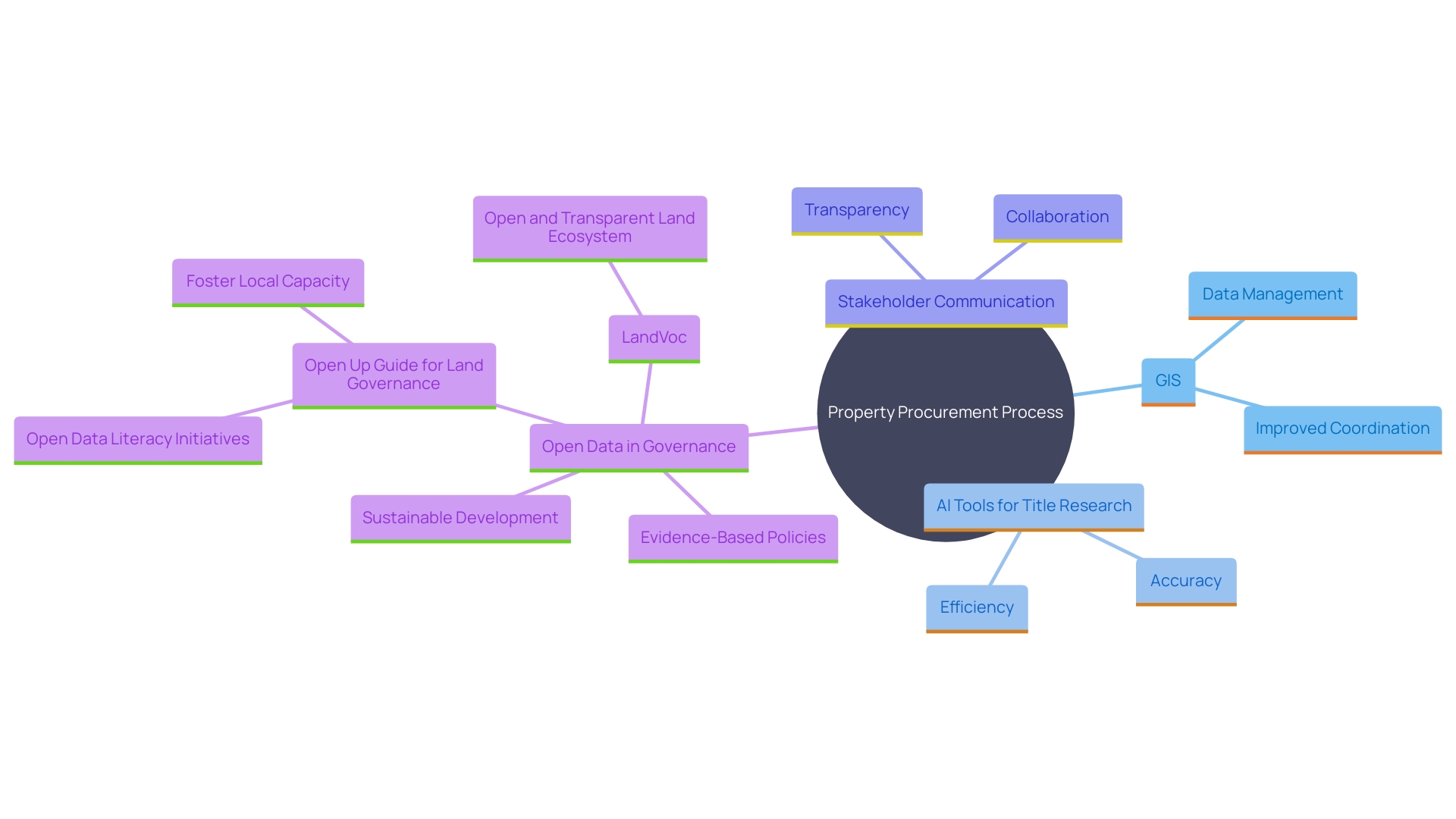Introduction
Right-of-way (ROW) acquisitions are a cornerstone of successful utility projects, necessitating a thorough understanding of legal frameworks and regulations. Key elements include identifying the necessary rights for the project, assessing the impact on landowners, and ensuring strict compliance with local, state, and federal laws. Engaging legal experts at the outset can significantly aid in navigating the complexities of ROW acquisitions.
Case studies like Fort Worth’s Lake Arlington Lift Station project highlight the practical challenges and solutions in ROW acquisitions. The city has used eminent domain six times since 2020 to facilitate the project, which underscores the importance of preparedness and strategic use of legal tools to overcome stalemates with property owners. In addition to legal expertise, proactive engagement with landowners is crucial.
Land agents conduct outreach to address questions, evaluate site-specific concerns, and discuss necessary easements. This approach ensures transparent communication and fosters cooperation, which is vital for the smooth progression of utility projects. Furthermore, construction crews must meticulously review the transmission line route, considering access constraints and environmental factors.
Field crews also carry out environmental and cultural resource evaluations, land use surveys, and infrastructure assessments as part of the required fieldwork. These comprehensive evaluations help in mitigating potential legal and logistical challenges. The successful implementation of ROW acquisitions requires a harmonious blend of legal acumen, strategic planning, and effective stakeholder communication, ensuring that utility projects progress efficiently and sustainably.
Understanding Right-of-Way Acquisitions
Right-of-way (ROW) procurements are a cornerstone of successful utility endeavors, necessitating a thorough understanding of legal frameworks and regulations. Key elements include identifying the necessary rights for the endeavor, assessing the impact on landowners, and ensuring strict compliance with local, state, and federal laws. Involving legal specialists from the beginning can greatly assist in maneuvering through the intricacies of ROW procurements.
Case studies such as Fort Worth’s Lake Arlington Lift Station initiative highlight the practical challenges and solutions in ROW acquisitions. The city has used eminent domain six times since 2020 to facilitate the initiative, which underscores the importance of preparedness and strategic use of legal tools to overcome stalemates with property owners.
In addition to legal expertise, proactive engagement with landowners is crucial. Land agents conduct outreach to address questions, evaluate site-specific concerns, and discuss necessary easements. This method guarantees clear communication and promotes collaboration, which is essential for the seamless advancement of utility initiatives.
Furthermore, construction crews must meticulously review the transmission line route, considering access constraints and environmental factors. Field crews also conduct environmental and cultural resource evaluations, area use surveys, and infrastructure assessments as part of the necessary fieldwork. These comprehensive evaluations help in mitigating potential legal and logistical challenges.
The successful execution of ROW acquisitions necessitates a harmonious mix of legal expertise, strategic planning, and effective stakeholder communication, ensuring that utility initiatives advance efficiently and sustainably.

Negotiation and Acquisition Best Practices
Successful negotiation is essential in obtaining land rights for utility initiatives, particularly in the context of substantial industrial developments. Building strong relationships with landowners can facilitate smoother negotiations. 'Transparent communication about the advantages of the initiative, addressing landowner concerns, and offering fair compensation are fundamental strategies.'. For instance, the DOE’s $7 billion Regional Clean H2Hubs program emphasizes the importance of community engagement during the negotiation phase, suggesting that successful collaboration with local communities, labor groups, environmental justice organizations, and tribal partners is necessary to achieve market liftoff for clean hydrogen projects.
Preparation is key to successful negotiations. Conducting thorough research on the land and its owner, as well as understanding market values and comparable transactions, is essential. 'This preparation can help overcome challenges such as asymmetric information or expertise, power imbalances, and lack of preparedness, which are common in negotiation situations.'. For example, the procedure of award negotiation for regional H2Hub applicants involves detailed planning and community engagement to lay the groundwork for future agreements.
Additionally, practical strategies that support negotiators include understanding the legal and regulatory frameworks, monitoring and enforcing compliance, and utilizing model contracts to manage risks and challenges. 'The recent regulatory changes in Ontario, which simplify environmental site evaluation requirements, underscore the significance of staying informed about regulatory updates to ensure efficient and compliant property purchasing activities.'.
Overall, effective negotiation requires a combination of relationship-building, thorough preparation, and strategic planning, supported by transparent communication and a deep understanding of the legal and regulatory landscape.

Importance of Early and Continuous Coordination
Successful property procurement for energy initiatives depends on prompt and ongoing collaboration with interested parties, including property owners, local authorities, and regulatory organizations. Engaging these stakeholders from the outset is crucial for identifying potential issues and fostering collaboration. Regular updates and meetings throughout the acquisition process ensure that all parties are informed and can provide input, ultimately leading to a more efficient and successful acquisition process.
Cooperation among the private sector, government bodies, and local communities allows stakeholders to collaborate in identifying appropriate areas for infrastructure development and tackling property tenure issues. For example, the organized documentation of territory and property rights is essential before construction can commence. This method not only avoids title conflicts and legal battles but also utilizes the worth of the property as collateral to draw in investment funds.
A case study from India emphasizes the significance of grouping solar generation to take advantage of shared facilities and utilize extensive regions of state-owned territory. This strategy facilitated the transformation of barren land into a solar park in Madhya Pradesh, showcasing how strategic land use can drive sustainable development.
Furthermore, the inclusion of less influential groups in decision-making processes is essential for the successful implementation of landscape and jurisdictional initiatives. Strengthening the participation of local communities ensures that projects are aligned with sustainable development goals and macro-objectives, fostering a more resilient and inclusive economy.
According to the 2023 Land Gap Report, governments worldwide have pledged 1 billion hectares of territory for carbon removal, emphasizing the need for transparent data regarding this space to support evidence-based policies. Open and transparent environmental ecosystems empower policymakers to design initiatives that enhance private sector engagement and support the development of a sustainable economy.
Environmental Considerations and Mitigation
When obtaining territory for utility endeavors, it is crucial to consider environmental effects thoroughly. Conducting environmental assessments, such as those using eco-evidence tools developed by researchers like McManamay et al. (2020), can identify sensitive areas requiring protection. These assessments are crucial in understanding which environmental indicators are most uncertain and need further research, thus informing early-stage impact evaluations.
Developing mitigation strategies to address potential environmental concerns not only ensures compliance with regulations but also boosts community support for the project. A study by Erlewein (2013) emphasized the importance of broadening the scope of environmental impact assessments to include the wider implications of major developments. This approach aligns with the Strategic Environmental Assessment (SEA) paradigm, which can address contemporary issues more effectively.
Working together with environmental specialists can offer important perspectives on sustainable practices during the land acquisition phase. Experts from institutions like Stanford have highlighted the need for robust standards that protect both the environment and frontline communities. This collaborative approach can also streamline the permitting process, making it more efficient while enhancing outcomes for environmental and human health and safety.
Furthermore, learning from the experiences of local planners in Colorado, who face challenges such as limited staff capacity and opposition from constituents, underscores the importance of strategic planning and stakeholder engagement. Addressing these challenges through informed decision-making and effective communication with elected officials, as suggested by utility leaders like Jeff Thorn, can mitigate potential conflicts and delays in implementation.
Leveraging Experienced Professionals
Involving skilled experts in land procurement is crucial for the seamless implementation of utility initiatives. These experts, often with backgrounds in real estate, law, and environmental science, bring a wealth of knowledge that can significantly streamline the acquisition process. Their comprehension of local markets and regulatory environments, along with skilled negotiation abilities, can result in more advantageous outcomes and lessen delays in work.
A case study involving the International Institute for Sustainable Development (IISD) highlights the significance of expertise in achieving success. In Costa Rica, the development of biological corridors in urban areas not only enhanced biodiversity but also supported sustainable city development, exemplifying how informed planning can yield multifaceted benefits.
Recent news reinforces the critical role of professionals in navigating complex regulatory environments. For instance, the City of San Fernando has seen a surge in accessory dwelling units (ADUs) due to new regulations, highlighting how expertise in local laws can drive development.
Statistics further demonstrate the impact of professional involvement. A study on wind energy projects revealed that the proximity of turbines to residential areas significantly affects property values. Specialists in property procurement can reduce such effects through strategic site selection and community involvement.
Quotes from industry leaders emphasize the necessity of informed planning and communication. Veronica Rivera of The Knight Law Firm notes that understanding regulatory frameworks is essential for those advising clients in the utility sector. This understanding corresponds with the wider goal of ensuring that property obtaining methods are both effective and advantageous to all parties concerned.

Utilizing Advanced Technologies for Coordination
Integrating advanced technologies into the property procurement process significantly improves coordination and data management. Geographic Information Systems (GIS) are essential in mapping potential sites and analyzing usage patterns, providing comprehensive data that supports informed decision-making. The incorporation of AI-driven tools for title research enhances precision and productivity, significantly decreasing the time needed for land purchases. This approach is exemplified by Wintershall Dea's implementation of AI@Scale, which standardizes data access and facilitates collaboration within their partner ecosystem, demonstrating the scalability of AI solutions in intricate operations. Moreover, utilizing technology enhances communication among stakeholders, ensuring all parties stay informed and engaged throughout the process of obtaining. The use of open and transparent data regarding territory, as promoted by the Portal's Open Up Guide for Governance, is essential in allowing governments to create evidence-based policies and strategic responses. These advancements not only optimize land acquisition but also contribute to sustainable development by providing a clearer understanding of land use and ownership.

Conclusion
Right-of-way (ROW) acquisitions represent a fundamental component of utility project success, requiring a comprehensive grasp of legal frameworks, stakeholder engagement, and environmental considerations. The importance of early and continuous coordination with landowners and regulatory bodies cannot be overstated; such collaboration lays the groundwork for effective negotiation and acquisition processes. Engaging legal experts and utilizing advanced technologies further enhances efficiency, ensuring compliance and minimizing potential conflicts.
Effective negotiation strategies hinge on building robust relationships with landowners and maintaining transparent communication. The necessity of thorough preparation, coupled with an understanding of local market dynamics, empowers negotiators to navigate complex discussions successfully. Additionally, leveraging experienced professionals aids in mitigating risks and streamlining the acquisition process, thereby facilitating timely project execution.
Environmental considerations play a critical role in ROW acquisitions, necessitating rigorous assessments and the development of mitigation strategies. Collaboration with environmental specialists fosters sustainable practices and enhances community support, which is vital for the long-term success of utility projects. By integrating advanced technologies such as GIS and AI, stakeholders can optimize data management and enhance coordination, ultimately driving sustainable development and efficient land acquisition.
In summary, a harmonious blend of legal expertise, strategic planning, and proactive stakeholder engagement is essential for effective ROW acquisitions. By prioritizing these elements, utility projects can progress smoothly, ensuring compliance with regulations while addressing the needs and concerns of all stakeholders involved.




